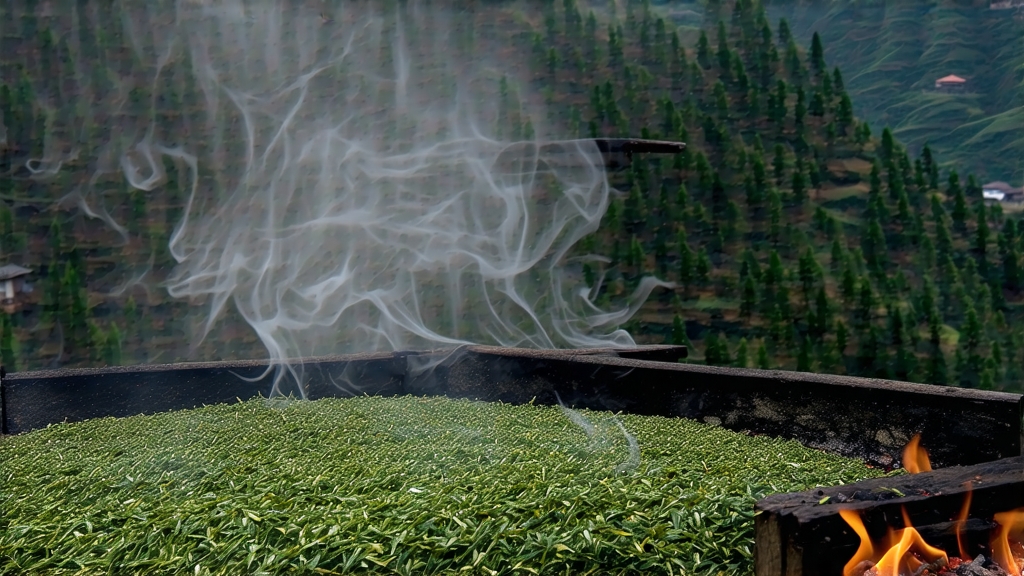
Lapsang Souchong—often written in old ledgers as “Bohea”—is the black tea that startled Europe three centuries ago and still divides drinkers today. To its admirers the cup is campfire and velvet, a sip of Chinese pine forests translated into liquor. To skeptics it is liquid bacon. Both reactions miss the subtlety that has allowed this leaf from the Wuyi massif of Fujian to outlive empires, tariffs, and fashion cycles. Understanding why requires walking the 1,200-metre passes of Tongmu village, listening for the crackle of fresh resin, and learning to coax sweetness from smoke.
History: From Mountain Refuge to London Drawing Rooms
The Song dynasty (960-1279) records mention “xiao zhong” (small sort) tea picked by monks who hid their leaf in bamboo tubes to escape bandits. Real documentary evidence, however, begins in 1646, when Qing soldiers pressed into the Wuyi foothills. Farmers, told to vacate, rushed the withering process over open fires to dry the leaf before fleeing. The accidental smoke contact was tasted weeks later on the quays of Xiamen, bought by Dutch factors, and shipped to Amsterdam as “thee van China” at prices that rivalled silver. By 1669 the British East India Company listed “Bohea Souchong” as a separate line item; Samuel Pepys drank it; Catherine of Braganza made it fashionable at court; and London coffee-houses added milk and sugar to tame its tarry edge. Thus the world’s first fully oxidised black tea—technically hong cha, “red tea” in Chinese—was born not from connoisseurship but from survival.
Micro-Terroirs: Three Faces of One Leaf
Today “Lapsang Souchong” is used as both a geographic indication and a style. Within the 600 km² Wuyi UNESCO reserve only leaf picked above 800 m in Tongmu, Guadun, and Miaowan may legally bear the name. Below that elevation the same cultivars become “Wuyi black” or “Fujian black.” Even inside Tongmu, three expressions exist:
- Traditional Pine-Smoked (Zheng Shan Xiao Zhong):
Fuelled exclusively by local Masson pine, 48-hour smoke exposure, then 6-month bamboo-basket resting to polymerise phenols. - New-Style or “Unsmoked” (Wu Yan Xiao Zhong):
Dried with electric warm air, showcasing honeyed yam and longan notes; aimed at modern Chinese palates. - Wild-Tree Micro-Lot:
Plucked from 200-year-old shrubs sprouting among rhododendron and fir; tiny yield, lychee-like aromatics, whisper of smoke because the room walls are impregnated with decades of resin.
Craft: When Fire Becomes Ingredient
The production calendar is brutally short: only six days between Qingming and Grain Rain when the alpine air is cool enough to slow oxidation. Picking standard is two leaves and a bud, but the bud must still be closed, “like a fish’s mouth” in local parlance. After 8–10 hours of solar withering on bamboo screens, the leaf is rolled under foot-powered wooden boards to rupture cells. The twist must be tight enough to release juice yet gentle enough to keep the strip whole—machines cannot match the judgement of a 40-year-old craftsman who listens for the sigh of moisture.
Oxidation happens in pine-wood trays stacked in a humid attic. Every 30 minutes the tea is fluffed so heat escapes evenly; the colour shifts from jade to copper to the “horse-blood red” that Song dynasty poets praised. Once 80 % of the leaf surface is chestnut, firing begins. A pit is dug in the earthen floor, pine logs 30 cm long are set alight, then covered with fresh sawdust to create a cool, aromatic smoke (28–32 °C). Workers wear reed capes so they can lie across the trough, turning the tea with bare hands. If the temperature rises one degree above 35 °C, the polyphenols will carbonise and the cup will taste of kerosene. After 30 cycles of 20-minute smoking and 40-minute resting, the moisture drops to 4 %. The tea is then left in unglazed clay jars for at least 90 days; during this “returning fire” phase, harsh creos